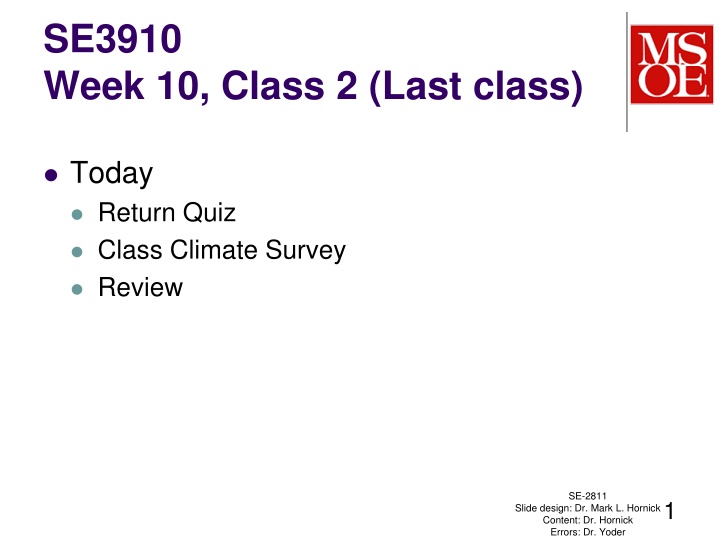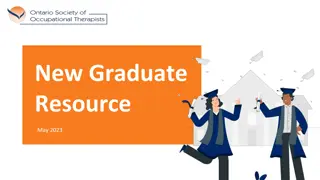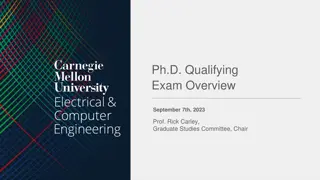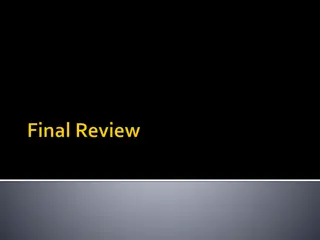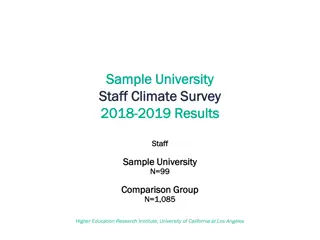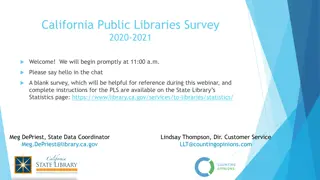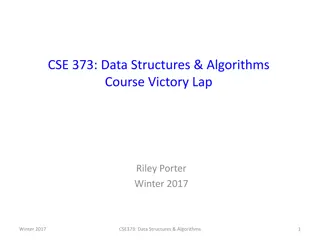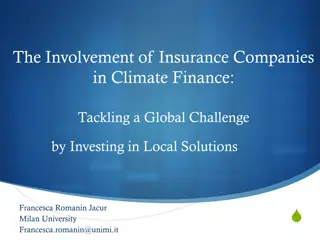Class Climate Survey and Final Exam Overview
The content includes details about the last class of SE3910, a quiz return, class climate survey, review materials for SE-2811, the overview of the course, and information about real-time systems and embedded systems. Dr. Josiah Yoder's slide designs and content on various topics related to embedded systems, real-time systems, and course material are highlighted. The slides also feature exercises on identifying real-time and embedded systems, as well as engaging content on circuits and resistors. Get insights into the core concepts covered in these classes.
Download Presentation

Please find below an Image/Link to download the presentation.
The content on the website is provided AS IS for your information and personal use only. It may not be sold, licensed, or shared on other websites without obtaining consent from the author.If you encounter any issues during the download, it is possible that the publisher has removed the file from their server.
You are allowed to download the files provided on this website for personal or commercial use, subject to the condition that they are used lawfully. All files are the property of their respective owners.
The content on the website is provided AS IS for your information and personal use only. It may not be sold, licensed, or shared on other websites without obtaining consent from the author.
E N D
Presentation Transcript
SE3910 Week 10, Class 2 (Last class) Today Return Quiz Class Climate Survey Review SE-2811 1 Slide design: Dr. Mark L. Hornick Content: Dr. Hornick Errors: Dr. Yoder
Final Exam SE 3910 021 Yoder Wednesday 2:00PM - 4:00PM S210 [2015] Source: http://www.msoe.edu/docs/DOC-5403 SE-2811 Dr.Yoder 2
Review Overview of course Muddiest Point of the quarter Practice Exercises from quarter TBA?: Graphical Overview of course TBA?: Review material for multithreading based on my review of your final projects SE-2811 Dr.Yoder 3
What is/was SE3910 about? Embedded Systems Terminology Electronics and Interfacing Low-level I/O (simple digital input and output) Real-Time Systems Terminology Meeting deadlines Predicting and measuring latency Predicting bandwidth, both analog and digital Scheduling, especially RMA Multithreading SE-2811 Dr.Yoder 4
SE-2811 Dr. Josiah Yoder 5
SE-2811 Dr. Josiah Yoder 6
Its got to be fast or does it? REAL-TIME SYSTEMS SE-2811 Dr.Yoder 7
Exercise Select all that are real-time systems Video Game Aircraft Autopilot Refinery Process Control Cash Register Smartphone a. b. c. d. e. SE-3910 - Dr. Josiah Yoder Slide style: Dr. Hornick Much Material: Dr. Schilling 8
Exercise Select all that are embedded systems Video Game Aircraft Autopilot Refinery Process Control Cash Register Smartphone a. b. c. d. e. SE-3910 - Dr. Josiah Yoder Slide style: Dr. Hornick Much Material: Dr. Schilling 9
What fun to wire and smoke CIRCUITS SE-2811 Dr.Yoder 10
Ex: What is the resistance of this resistor? SE-3910 - Dr. Josiah Yoder Slide style: Dr. Hornick Much Material: Dr. Schilling 11
Ex: What is the resistance of this resistor? SE-3910 - Dr. Josiah Yoder Slide style: Dr. Hornick Much Material: Dr. Schilling 12
Ex: What is the resistance of this resistor? 13
Ex: What is the resistance of this resistor? 14
Ex: What is the resistance of this resistor? 15
Ex: What is the resistance of this resistor? 16 ORANGE ORANGE VIOLET GOLD
Ex: GPIO safety Considering any one of the resistors on the previous slides, is it large enough to not damage a GPIO pin configured as output, if the resistor ties the output to ground? Sourcing limit: 4mA Sinking limit: 8mA Voltage: 3.3 V SE-2811 Dr.Yoder 17
Ex: GPIO safety Considering any one of the resistors on the previous slides, is it large enough to not damage a GPIO pin configured as output, if the resistor ties the output to 3.3V? Sourcing limit: 4mA Sinking limit: 8mA Voltage: 3.3 V SE-2811 Dr.Yoder 18
Ex: What is the voltage across R2? SE-3910 - Dr. Josiah Yoder Slide style: Dr. Hornick Much Material: Dr. Schilling 19
Ex: Compute voltage across C1 If S1 is closed, and S2 is opened, what is the voltage across C1? If S2 is closed, and S1 is opened? If both are opened? If both are closed? SE-2811 Dr.Yoder 20
Ex: Compute voltage into GPIO If S1 is open and S2 is closed, compute the voltage from GPIO 12 to ground. (Assume GPIO 12 is not connected to anything) SE-2811 Dr. Yoder 21
Ex: Whats wrong with this simple circuit s input? SE-3910 - Dr. Josiah Yoder Slide style: Dr. Hornick Much Material: Dr. Schilling 22
Ex: Whats wrong with this circuit? (The worst thing) SE-3910 Dr.Yoder 23
Exercise: Find all of: Voltage from GPIO to ground if S1 is closed S2 is closed Both are open Current from source if both are closed SE-2811 Dr.Yoder 24
Selecting an LED resistance value Suppose L1 is a diode with Vd = 1.8 V Ex: Write a formula relating the current through L1 to R1. Ex: Solve for R1 if we want the (max) current to be 10 mA. SE-2811 Dr.Yoder 25
Its like Java, only with pointers C LANGUAGE SE-2811 Dr Yoder 26
(Extra Exercise) Why does this 6 unsigned short *pt; 7 pt = myArray[0]; Produce this? myLib.c:7: error: data definition has no type or storage class myLib.c:7: error: type defaults to 'int' in declaration of 'pt' myLib.c:7: error: conflicting types for 'pt' myLib.c:6: note: previous declaration of 'pt' was here myLib.c:7: error: initialization makes integer from pointer without a cast How should it be written? Are these compile or link errors? SE-2811 Dr Yoder 27
Exercise: Which of the following is correct? void foo(struct bar2* b); struct bar b; And then . foo((struct bar2*) b*) foo((bar2*) *b) foo((bar2*) b&) foo((struct bar2*) &b) SE-3910 - Dr. Josiah Yoder Slide style: Dr. Hornick Much Material: Dr. Schilling 28
Exercise How do you get a reference (pointer) to the first element in an array? int x[5] = {1,2,3,4,5} boolean foo(int *ip); a) foo(&x); b) foo(&x[0]); c) foo(x); d) foo(x[0]); SE-3910 - Dr. Josiah Yoder Slide style: Dr. Hornick Much Material: Dr. Schilling 29
Exercise How do you get a reference (pointer) to the second element in an array? int x[5] = {1,2,3,4,5} boolean foo(int *ip); a) foo(&x+1); b) foo(&x[0]); c) foo(x+1); d) foo(x[0]); e) foo(&(x+1)); Slide style: Dr. Hornick Much Material: Dr. Schilling SE-3910 - Dr. Josiah Yoder 30
Ex: C/C++ (Review) Why do we have both .h and .cpp file extensions for C++? Why not just have .cpp (like .java for Java classes)? Answer these questions: 1. What should you put into a class s .h file? 2. What should you put into a class s .cpp file? [Note: On next lab, use .hpp and .cpp instead of .h and .cpp] SE-2811 Dr.Yoder 31
Ex: C/C++ Circle the link-time errors. Box the compile- time cannot find -lasound [NEW!!! (As of Quiz 5)] syntax error warning: implicit declaration of function `...' point.m:40: error: mypoint undeclared (first use in this function) parse error before `... collect2: ld returned 1 exit status undefined reference to `filterText' /usr/lib/crt1.o(.text+0x18): undefined reference to SE-2811 Dr.Yoder 32
Quiz Practice: C/C++ Circle the link-time errors. Box the compile- time syntax error point.m:40: error: mypoint undeclared (first use in this function) collect2: ld returned 1 exit status /usr/lib/crt1.o(.text+0x18): undefined reference to `main ' parse error before `... undefined reference to `filterText' warning: implicit declaration of function `...' SE-2811 Dr.Yoder 33
Wiggly and squiggly SIGNALS SE-2811 Dr.Yoder 34
Exercise: What is the time delay between the two falling edges? SE-3910 - Dr. Josiah Yoder Slide style: Dr. Hornick Much Material: Dr. Schilling 35
Exercise: What is the time delay between the two falling edges? 5 ms / Div SE-3910 - Dr. Josiah Yoder Slide style: Dr. Hornick Much Material: Dr. Schilling 36
Exercise: What is the rise-time of this signal? 1 Volt/div 1 ms/div 0 SE-3910 - Dr. Josiah Yoder Slide style: Dr. Hornick Much Material: Dr. Schilling 37
[Witty saying needed] DATA-RATES SE-2811 Dr.Yoder 38
TODO: Get all the noisy-analog-channel data-rates SE-2811 Dr Yoder 39
SI multipliers P = 1,000,0000,000,000,000 T = 1,000,000,000,000 G = 1,000,000,000 M = 1,000,000 K = 1,000 () = 1 m = 1/1,000 us = 1/1,000,000 ns = 1/1,000,000,000 (us = s) SE-3910 - Dr. Josiah Yoder Slide style: Dr. Hornick Much Material: Dr. Schilling 40
Binary multipliers Pi = 10245 Ti = 10244 Gi = 10243 Mi = 10242 Ki = 1,024 () = 1 SE-3910 - Dr. Josiah Yoder Slide style: Dr. Hornick Much Material: Dr. Schilling 41
Ex How many SI Kb is 4 Gibibytes (GiB)? Note: That s SI kilobits, not kilobytes! SE-2811 Dr.Yoder 42
Ex: Suppose you are designing a real-time system, and the remote display design team says they can handle a data rate of 100MB/s according to their current design. What should you ask? SE-2811 Dr. Yoder 43
Quiz practice: Analog to digital bandwidth ????2 (1 +? ?) Suppose you would like to send video in a (relatively) low-frequency with a narrow bandwidth of 1 Mhz The connection is fairly noisy and you can only get 20dB SNR What bit-rate can you achieve? (use closest binary multiplier) 44 SE-3910 - Dr. Josiah Yoder
Buffering With 1 KB buffer, there will be ____ samples per buffer. With a 40KHz sampling rate, the buffer must be filled every ____ milliseconds (audio deadline) With 40KHz sampling, the maximum frequency sine-wave that can be encoded is SE-2811 Dr.Yoder 45
Ex TODO: Various unit analyses (e.g. audio rates, video rates, Nyquist theorem) SE-2811 Dr.Yoder 46
When will I ever get all this done? SCHEDULING SE-2811 Dr.Yoder 47
Rate-Monotonic Example SE-3910 - Dr. Josiah Yoder Slide style: Dr. Hornick Much Material: Dr. Schilling 48
Other RMA and Scheduling questions Does this meet the theoretical 69% bound? Is it guaranteed to succeed? Is it guaranteed to fail? What simplifying assumptions do we make in RMA scheduling? Round-robin vs. Cyclic Code Scheduling SE-2811 Dr Yoder 49
Two hands, twice the productivity MULTITHREADING SE-2811 Dr.Yoder 50
